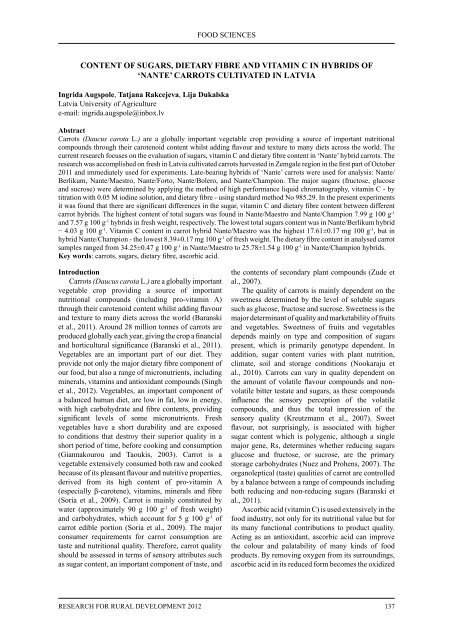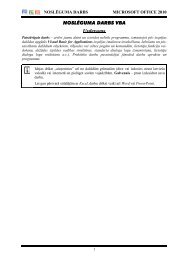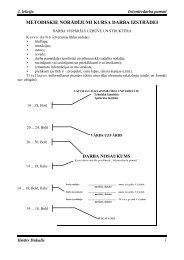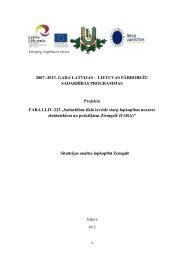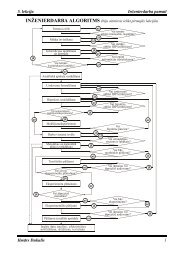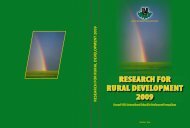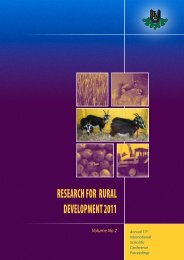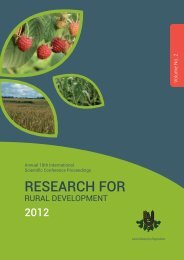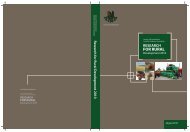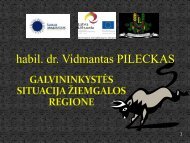LATVIA UNIVERSITY OF AGRICULTURE - Latvijas ...
LATVIA UNIVERSITY OF AGRICULTURE - Latvijas ...
LATVIA UNIVERSITY OF AGRICULTURE - Latvijas ...
- No tags were found...
You also want an ePaper? Increase the reach of your titles
YUMPU automatically turns print PDFs into web optimized ePapers that Google loves.
FOOD SCIENCEScontent <strong>OF</strong> sugars, DIETARY fibre and vitamin C in hybrids of‘Nante’ carrots CULTIVATED in <strong>LATVIA</strong>Ingrida Augspole, Tatjana Rakcejeva, Lija DukalskaLatvia University of Agriculturee-mail: ingrida.augspole@inbox.lvAbstractCarrots (Daucus carota L.) are a globally important vegetable crop providing a source of important nutritionalcompounds through their carotenoid content whilst adding flavour and texture to many diets across the world. Thecurrent research focuses on the evaluation of sugars, vitamin C and dietary fibre content in ‘Nante’ hybrid carrots. Theresearch was accomplished on fresh in Latvia cultivated carrots harvested in Zemgale region in the first part of October2011 and immediately used for experiments. Late-bearing hybrids of ‘Nante’ carrots were used for analysis: Nante/Berlikum, Nante/Maestro, Nante/Forto, Nante/Bolero, and Nante/Champion. The major sugars (fructose, glucoseand sucrose) were determined by applying the method of high performance liquid chromatography, vitamin C - bytitration with 0.05 M iodine solution, and dietary fibre - using standard method No 985.29. In the present experimentsit was found that there are significant differences in the sugar, vitamin C and dietary fibre content between differentcarrot hybrids. The highest content of total sugars was found in Nante/Maestro and Nante/Champion 7.99 g 100 g -1and 7.57 g 100 g -1 hybrids in fresh weight, respectively. The lowest total sugars content was in Nante/Berlikum hybrid− 4.03 g 100 g -1 . Vitamin C content in carrot hybrid Nante/Maestro was the highest 17.61±0.17 mg 100 g -1 , but inhybrid Nante/Champion - the lowest 8.39±0.17 mg 100 g -1 of fresh weight. The dietary fibre content in analysed carrotsamples ranged from 34.25±0.47 g 100 g -1 in Nante/Maestro to 25.78±1.54 g 100 g -1 in Nante/Champion hybrids.Key words: carrots, sugars, dietary fibre, ascorbic acid.IntroductionCarrots (Daucus carota L.) are a globally importantvegetable crop providing a source of importantnutritional compounds (including pro-vitamin A)through their carotenoid content whilst adding flavourand texture to many diets across the world (Baranskiet al., 2011). Around 28 million tonnes of carrots areproduced globally each year, giving the crop a financialand horticultural significance (Baranski et al., 2011).Vegetables are an important part of our diet. Theyprovide not only the major dietary fibre component ofour food, but also a range of micronutrients, includingminerals, vitamins and antioxidant compounds (Singhet al., 2012). Vegetables, an important component ofa balanced human diet, are low in fat, low in energy,with high carbohydrate and fibre contents, providingsignificant levels of some micronutrients. Freshvegetables have a short durability and are exposedto conditions that destroy their superior quality in ashort period of time, before cooking and consumption(Giannakourou and Taoukis, 2003). Carrot is avegetable extensively consumed both raw and cookedbecause of its pleasant flavour and nutritive properties,derived from its high content of pro-vitamin A(especially β-carotene), vitamins, minerals and fibre(Soria et al., 2009). Carrot is mainly constituted bywater (approximately 90 g 100 g -1 of fresh weight)and carbohydrates, which account for 5 g 100 g -1 ofcarrot edible portion (Soria et al., 2009). The majorconsumer requirements for carrot consumption aretaste and nutritional quality. Therefore, carrot qualityshould be assessed in terms of sensory attributes suchas sugar content, an important component of taste, andthe contents of secondary plant compounds (Zude etal., 2007).The quality of carrots is mainly dependent on thesweetness determined by the level of soluble sugarssuch as glucose, fructose and sucrose. Sweetness is themajor determinant of quality and marketability of fruitsand vegetables. Sweetness of fruits and vegetablesdepends mainly on type and composition of sugarspresent, which is primarily genotype dependent. Inaddition, sugar content varies with plant nutrition,climate, soil and storage conditions (Nookaraju etal., 2010). Carrots can vary in quality dependent onthe amount of volatile flavour compounds and nonvolatilebitter testate and sugars, as these compoundsinfluence the sensory perception of the volatilecompounds, and thus the total impression of thesensory quality (Kreutzmann et al., 2007). Sweetflavour, not surprisingly, is associated with highersugar content which is polygenic, although a singlemajor gene, Rs, determines whether reducing sugarsglucose and fructose, or sucrose, are the primarystorage carbohydrates (Nuez and Prohens, 2007). Theorganoleptical (taste) qualities of carrot are controlledby a balance between a range of compounds includingboth reducing and non-reducing sugars (Baranski etal., 2011).Ascorbic acid (vitamin C) is used extensively in thefood industry, not only for its nutritional value but forits many functional contributions to product quality.Acting as an antioxidant, ascorbic acid can improvethe colour and palatability of many kinds of foodproducts. By removing oxygen from its surroundings,ascorbic acid in its reduced form becomes the oxidizedResearch for Rural Development 2012137


